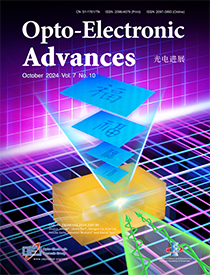2024 Vol. 7, No. 10
Cover story: Zheng SJ, Tan JR, Liu HJ et al. Orthogonal matrix of polarization combinations: concept and application to multichannel holographic recording. Opto-Electron Adv 7, 230180 (2024).
Orthogonal matrices are a fundamental mathematical concept with widespread applications in various scientific and engineering fields. Polarization modulation is a technology for regulating the orientation of electromagnetic wave vibrations and offers numerous advantages across different domains. Although current orthogonal matrices demonstrate proficiency in amplitude-phase modulation, they encounter limitations in polarization modulation. Infinite orthogonal matrices with the capability for polarization modulation are notably scarce. The research group, under the leadership of Professor Xiaodi Tan from Fujian Normal University, collaborated with the research group led by Professor Takanori Nomura from Wakayama University to put forth a methodology for the construction of multi-dimensional non-square Orthogonal Matrix of Polarization Combinations (OMPC). Indeed, the proposal of OMPC offers significant advantages in expanding the multiplexing capacity of polarization holography in the polarization dimension. During the experiment, specialized holographic materials sensitive to polarization were utilized, and four distinct images were recorded internally using a 4-dimensional OMPC. By modifying the state of incident dual-component polarized light, it becomes feasible to reconstruct each of the four images either individually or simultaneously. The results of the analysis demonstrate the robustness and effectiveness of the method when applied to phenanthrenequinone-doped polymethyl methacrylate (PQ/PMMA) materials. The novel approach exhibits promising potential in substantially enhancing the multiplexing capacity of multi-channel holograms. This advancement broadens the application scope of polarization holography, particularly in the domains of optical storage and information security. OMPC offers unprecedented opportunities for polarization holographic multi-channel multiplexing. This work provides new insights for the realization of functions such as dynamic image display and optical holographic encryption.

-
{{article.year}}, {{article.volume}}({{article.issue}}): {{article.fpage | processPage:article.lpage:6}}. doi: {{article.doi}}{{article.articleStateNameEn}}, Published online {{article.preferredDate | date:'dd MMMM yyyy'}}, doi: {{article.doi}}{{article.articleStateNameEn}}, Accepted Date {{article.acceptedDate | date:'dd MMMM yyyy'}}CSTR: {{article.cstr}}
-
{{article.year}}, {{article.volume}}({{article.issue}}): {{article.fpage | processPage:article.lpage:6}}. doi: {{article.doi}}{{article.articleStateNameEn}}, Published online {{article.preferredDate | date:'dd MMMM yyyy'}}, doi: {{article.doi}}{{article.articleStateNameEn}}, Accepted Date {{article.acceptedDate | date:'dd MMMM yyyy'}}CSTR: {{article.cstr}}

 E-mail Alert
E-mail Alert RSS
RSS


